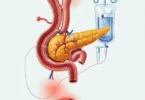Craniopharyngiomas: Drug therapy
Drug treatment is not available for Craniopharyngiomas. Pilot studies with interferon alpha treatment showed a high rate of side effects and a low response, so that currently they cannot be recommended for treatment. Almost in all patients, as a result of tumor growth there is decreased in secretion of pituitary hormones and subsequent hormonal glands. Therefore, the corresponding hormones need to be replaced, such as thyroid hormone (L-thyroxine) or adrenal hormone (hydrocortisone), in diabetes insipidus the synthetic hormone Minirin.
Craniopharyngiomas: Operation
The primary therapy should be as surgical removal of the tumor. The surgical access through the nose (transnasal surgery) is preferable. Patients with a craniopharyngioma should be operated in a neurosurgical specialized center by a neurosurgeon experienced in the pituitary surgery to keep the surgery related morbidity and mortality (when radical surgery to 20%) as low as possible. It is not always advisable to go for a complete removal of the tumor, as the complication rate rises in very radical operations (including risk of developing personality disorders, permanent diabetes insipidus). there is an evidence of increase in weight after surgical treatments due to hormone failure . After surgery, a diabetes insipidus is determined in about 70-90% of patients. Hormone failures are detectable in 80-90% of patients, hormone replacement treatment is necessary here.
Craniopharyngiomas: Radiotherapy
Suitable facilities for irradiation depend on the size and location of residual tumor in skull. In addition to the conventional fractionated irradiation of pituitary region newer methods such as stereotactic radiation with a so-called linear accelerator or the Gamma Knife can be used. The combination of surgery and radiation leads to an assessed cure rate of 70-83% after 10 years. As long term consequence of radiation therapy can be expected with a loss of hormone production of the pituitary gland. The incorporation of radioactively labeled substances such as Yttrium-90 or phosphorus-32 is possible in individual cases as therapeutic trial in cystic tumors. By the local irradiation a reduction in cyst can be achieved.
Craniopharyngiomas: Aftercare
Patients with a craniopharyngioma need lifelong follow-up, because the disease can recur. In addition to clinical and endocrinological studies, annual MRI inspection of the sella region and ophthalmological examinations is necessary. If relapse occur, a renewed surgical treatment, may be necessary followed by radiation therapy. If it is purely a cyst, a cyst puncture can be done. A lifelong aftercare is essential because of the need of replacement therapy with hormones in many patients.
The reduced quality of life of patients with a craniopharyngioma is a major problem. This is due to the growth of the tumor into adjacent brain structures witch control important functions of life and perhaps even through surgical procedures. High-grade obesity sequelae are often detectable in 30% of patients such as diabetes and heart disease. One goal of medical services is to influence the development of obesity and thus to maintain the quality of life of patients for long term with a craniopharyngioma.
For more general information:






